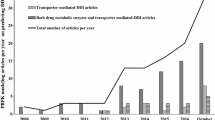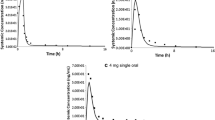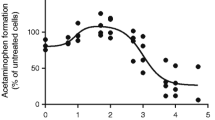Abstract
Purpose
Rivaroxaban is a direct oral anticoagulant with a large inter-individual variability. The present study is to develop a physiologically based pharmacokinetic (PBPK) model to predict several scenarios in clinical practice.
Methods
A whole-body PBPK model for rivaroxaban, which is metabolized by the cytochrome P450 (CYP) 3A4/5, 2J2 pathways and excreted via kidneys, was developed to predict the pharmacokinetics at different doses in healthy subjects and patients with hepatic or renal dysfunction. Hepatic clearance and drug-drug interactions (DDI) were estimated by in vitro in vivo extrapolation (IVIVE) based on parameters obtained from in vitro experiments. To validate the model, observed concentrations were compared with predicted concentrations, and the impact of special scenarios was investigated.
Results
The PBPK model successfully predicted the pharmacokinetics for healthy subjects and patients as well as DDIs. Sensitivity analysis shows that age, renal, and hepatic clearance are important factors affecting rivaroxaban pharmacokinetics. The predicted fold increase of rivaroxaban AUC values when combined administered with the inhibitors such as ketoconazole, ritonavir, and clarithromycin were 2.3, 2.2, and 1.3, respectively. When DDIs and hepatic dysfunction coexist, the fold increase of rivaroxaban exposure would increase significantly compared with one factor alone.
Conclusions
Our study using PBPK modeling provided a reasonable approach to evaluate exposure levels in special patients under special scenarios. Although further clinical study or real-life experience would certainly merit the current work, the modeling work so far would at least suggest caution of using rivaroxaban in complicated clinical settings.




Similar content being viewed by others
References
Capodanno D, Giacchi G, Tamburino C (2012) Novel drugs for oral anticoagulation pharmacotherapy. Expert Rev Cardiovasc Ther 10(4):473–488
Powell JR (2015) Are new oral anticoagulant dosing recommendations optimal for all patients? JAMA 313(10):1013–1014
Mueck W, Stampfuss J, Kubitza D, Becka M (2014) Clinical pharmacokinetic and pharmacodynamic profile of rivaroxaban. Clin Pharmacokinet 53(1):1–16
Kubitza D, Becka M, Zuehlsdorf M, Mueck W (2006) Effect of food, an antacid, and the H2 antagonist ranitidine on the absorption of BAY 59-7939 (rivaroxaban), an oral, direct factor Xa inhibitor, in healthy subjects. J Clin Pharmacol 46(5):549–558
Lang D, Freudenberger C, Weinz C (2009) In vitro metabolism of rivaroxaban, an oral, direct factor Xa inhibitor, in liver microsomes and hepatocytes of rats, dogs, and humans. Drug Metab Disposition: Biol Fate Chem 37(5):1046–1055
Gnoth MJ, Buetehorn U, Muenster U, Schwarz T, Sandmann S (2011) In vitro and in vivo P-glycoprotein transport characteristics of rivaroxaban. J Pharmacol Exp Ther 338(1):372–380
Mueck W, Kubitza D, Becka M (2013) Co-administration of rivaroxaban with drugs that share its elimination pathways: pharmacokinetic effects in healthy subjects. Br J Clin Pharmacol 76(3):455–466
Kubitza D, Becka M, Mueck W, Halabi A, Maatouk H, Klause N, Lufft V, Wand DD, Philipp T, Bruck H (2010) Effects of renal impairment on the pharmacokinetics, pharmacodynamics and safety of rivaroxaban, an oral, direct factor Xa inhibitor. Br J Clin Pharmacol 70(5):703–712
Kubitza D, Roth A, Becka M, Alatrach A, Halabi A, Hinrichsen H, Mueck W (2013) Effect of hepatic impairment on the pharmacokinetics and pharmacodynamics of a single dose of rivaroxaban, an oral, direct factor Xa inhibitor. Br J Clin Pharmacol 76(1):89–98
Hartmanshenn C, Scherholz M, Androulakis IP (2016) Physiologically-based pharmacokinetic models: approaches for enabling personalized medicine. J Pharmacokinet Pharmacodyn 43(5):481–504
Zhou S, Yung Chan S, Cher Goh B, Chan E, Duan W, Huang M, McLeod HL (2005) Mechanism-based inhibition of cytochrome P450 3A4 by therapeutic drugs. Clin Pharmacokinet 44(3):279–304
Grillo JA, Zhao P, Bullock J, Booth BP, Lu M, Robie-Suh K, Berglund EG, Pang KS, Rahman A, Zhang L, Lesko LJ, Huang SM (2012) Utility of a physiologically-based pharmacokinetic (PBPK) modeling approach to quantitatively predict a complex drug-drug-disease interaction scenario for rivaroxaban during the drug review process: implications for clinical practice. Biopharm Drug Dispos 33(2):99–110
Poulin P, Theil FP (2000) A priori prediction of tissue:plasma partition coefficients of drugs to facilitate the use of physiologically-based pharmacokinetic models in drug discovery. J Pharm Sci 89(1):16–35
Lu Y, Zhu J, Chen X, Li N, Fu F, He J, Wang G, Zhang L, Zheng Y, Qiu Z, Yu X, Han D, Wu L (2009) Identification of human UDP-glucuronosyltransferase isoforms responsible for the glucuronidation of glycyrrhetinic acid. Drug Metab Pharmacokinet 24(6):523–528
Weinz C, Schwarz T, Kubitza D, Mueck W, Lang D (2009) Metabolism and excretion of rivaroxaban, an oral, direct factor Xa inhibitor, in rats, dogs, and humans. Drug Metab Disposition: Biol Fate Chem 37(5):1056–1064
Yu CY, Lo YH, Chiou WK (2003) The 3D scanner for measuring body surface area: a simplified calculation in the Chinese adult. Appl Ergon 34(3):273–278
Katori R (1979) Normal cardiac output in relation to age and body size. Tohoku J Exp Med 128(4):377–387
Cockcroft DW, Gault MH (1976) Prediction of creatinine clearance from serum creatinine. Nephron 16(1):31–41
Fraschini F, Scaglione F, Demartini G (1993) Clarithromycin clinical pharmacokinetics. Clin Pharmacokinet 25(3):189–204
Huang YC, Colaizzi JL, Bierman RH, Woestenborghs R, Heykants J (1986) Pharmacokinetics and dose proportionality of ketoconazole in normal volunteers. Antimicrob Agents Chemother 30(2):206–210
Wang K, D'Argenio DZ, Acosta EP, Sheth AN, Delille C, Lennox JL, Kerstner-Wood C, Ofotokun I (2014) Integrated population pharmacokinetic/viral dynamic modelling of lopinavir/ritonavir in HIV-1 treatment-naive patients. Clin Pharmacokinet 53(4):361–371
Jiang J, Hu Y, Zhang J, Yang J, Mueck W, Kubitza D, Bauer RJ, Meng L, Hu P (2010) Safety, pharmacokinetics and pharmacodynamics of single doses of rivaroxaban - an oral, direct factor Xa inhibitor - in elderly Chinese subjects. Thromb Haemost 103(1):234–241
Guo H, Liu C, Li J, Zhang M, Hu M, Xu P, Liu L, Liu X (2013) A mechanistic physiologically based pharmacokinetic-enzyme turnover model involving both intestine and liver to predict CYP3A induction-mediated drug-drug interactions. J Pharm Sci 102(8):2819–2836
Runge C (1895) Über die numerische Auflösung von Differentialgleichungen. Math Annalen 46:167–178
Kutta W (1901) Beitrag zur näherungsweisen Integration totaler Differentialgleichungen. Z Math Phys 46:435–453
Kubitza D, Becka M, Roth A, Mueck W (2013) The influence of age and gender on the pharmacokinetics and pharmacodynamics of rivaroxaban--an oral, direct factor Xa inhibitor. J Clin Pharmacol 53(3):249–255
Zhao X, Sun P, Zhou Y, Liu Y, Zhang H, Mueck W, Kubitza D, Bauer RJ, Zhang H, Cui Y (2009) Safety, pharmacokinetics and pharmacodynamics of single/multiple doses of the oral, direct factor Xa inhibitor rivaroxaban in healthy Chinese subjects. Br J Clin Pharmacol 68(1):77–88
Douxfils J, Mullier F, Loosen C, Chatelain C, Chatelain B, Dogne JM (2012) Assessment of the impact of rivaroxaban on coagulation assays: laboratory recommendations for the monitoring of rivaroxaban and review of the literature. Thromb Res 130(6):956–966
Grillo JA, Bullock JM, Mehrotra N, Garnett C, Zhao P (2010) US Food and Drug Administration, Center for Drug Evaluation and Research. Clinical pharmacology and biopharmaceutics review(s). https://www.accessdata.fda.gov/drugsatfda_docs/nda/2011/022406Orig022401s022000ClinPharmR.pdf
Brown RP, Delp MD, Lindstedt SL, Rhomberg LR, Beliles RP (1997) Physiological parameter values for physiologically based pharmacokinetic models. Toxicol Ind Health 13(4):407–484
Author information
Authors and Affiliations
Contributions
Ruijuan Xu developed the model and performed the validation. All the authors contributed the discussion of results. Ruijuan Xu wrote the first draft. All the authors reviewed the data and approved the final version of submission.
Corresponding authors
Ethics declarations
Conflict of interest
This work was supported by the Key Research and Development program of Jiangsu Province of China (No. BE2016608). We thank Professor Jin Yang from China Pharmaceutical University for providing SimCYP® software (Version 14.0).
Rights and permissions
About this article
Cite this article
Xu, R., Ge, W. & Jiang, Q. Application of physiologically based pharmacokinetic modeling to the prediction of drug-drug and drug-disease interactions for rivaroxaban. Eur J Clin Pharmacol 74, 755–765 (2018). https://doi.org/10.1007/s00228-018-2430-8
Received:
Accepted:
Published:
Issue Date:
DOI: https://doi.org/10.1007/s00228-018-2430-8




